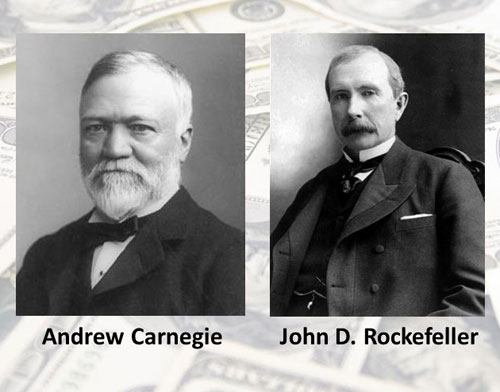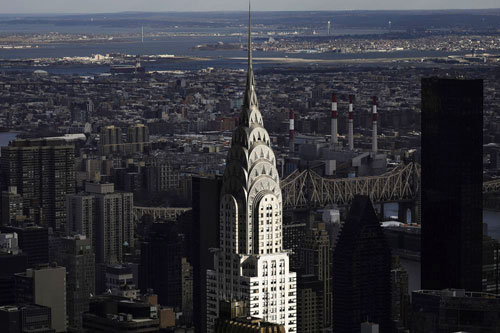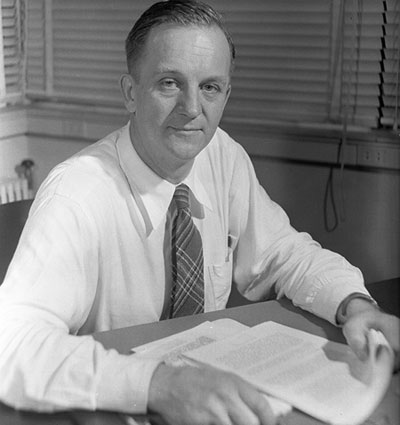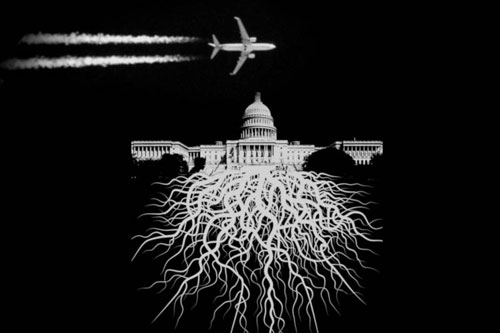Chemtrails Exposed: The Research Corporation for Science Advancement and the Origins of the New Manhattan Project (2)
By Peter A. Kirby
Read the first part of the article
In 1920, Cottrell briefly served as the chief of the
Bureau of Mines for 8 months. Beginning in 1921 Cottrell also served as the chairman of
the National Research Council’s Division of Chemistry and Chemical Technology. The
National Research Council was funded by the Carnegie and Rockefeller Foundations, among
others. This put him in touch with Rockefellers and Carnegies – two family names
highly correlated with the New Manhattan Project.

With the exception of an early grant to Cottrell as
part of a company promotion, the Research Corporation didn’t really start giving
out money for the advancement of science until 1923. In 1923 the Research Corporation
made their first real grant when they paid $5K toward the atmospheric sounding rocket
experiments of the American rocketry pioneer Robert H. Goddard (1882-1945). This was an
investment in the atmospheric sciences as sounding rockets are used to gather
atmospheric data. From the beginning, the Research Corporation was funding projects
highly relevant to the New Manhattan Project. As we will soon see, many others were
funded later.
At the Research Corporation, the way it worked was
that Howard Poillon ran day-to-day operations while Cottrell was largely responsible for
developing new inventions and ideas, accepting new patents, and the granting of funds.
Cottrell’s official status was that of a paid consultant.
Another early recipient of Research Corporation money
was Ernest Orlando Lawrence (1901-1958): Manhattan Project scientist and the father of
the cyclotron. In 1931 the Research Corporation made the first of many grants to Ernest
Lawrence for the development of his cyclotron.
In late July of 1931, after Lawrence had successfully
produced a million-volt proton with an eleven inch accelerator, Fred Cottrell encouraged
his friend from UC Berkeley to ask the Research Corporation for funding. Before the end
of the month, Lawrence was in New York, asking the Research Corporation for $10-$15K.
Cottrell came along to personally introduce Lawrence and plead his case before the board
of directors. The Research Corporation was impressed with Lawrence and they decided to
make a $5K grant, even though they had to go to the bank and borrow the funds because
they were in the throes of the Great Depression. William Buffum of the Chemical
Foundation followed up with a promise of another $2.5K.
On different occasions between 1931 and 1940, the
Research Corporation gave to Lawrence’s work at the Berkeley Radiation Laboratory:
$5K, $1.8K, $2K, $2K, $3K, $1K, $5K, $1.7K, $7.5K, $5K, and $50K. That’s a grand
total of $84K, or, conservatively, about $1.5M in today’s dollars.
The Research Corporation, as the assignee, also
applied for one of Lawrence’s patents for him. Their collaborative patent
“Method and Apparatus for the Acceleration of Ions” covers methods
of the cyclotronic production of radioactive substances discovered by Lawrence.
Cottrell’s biographer Cameron writes,
“In the thirties, when the period of intensive study of atomic energy began,
the earliest diversified support and encouragement of the development of the techniques
of nuclear physics in America came from Research Corporation.” He also writes,
“The Lawrence patent had, by 1949, been licensed free of royalties to twenty-eight
universities and scientific institutions to build cyclotrons. More than that, it was
income from the precipitation patents that helped in several instances to build or
operate these cyclotrons which the corporation licensed.”
Along with funding Lawrence, the Research Corporation
funded other early cyclotron work at: Columbia University, the University of Rochester,
the University of Chicago, and Cornell University.
The Research Corporation also funded Robert Van de
Graaff’s (1901-1967) electrostatic generator, also known as a Van de Graaff-Trump
accelerator after the Donald’s uncle, John G. Trump (1907-1985). Van de
Graaff’s work was conducted at MIT. Cameron writes, “[The Van de Graaff
group of patents on the electrostatic generator] were assigned to Research Corporation
under a general agreement with Massachusetts Institute of Technology and in turn were
ultimately licensed back to the High Voltage Engineering Corporation formed by Van de
Graaff and his associates.” Van de Graaff’s associates included John
Trump. As readers of this work already know, John Trump was the MIT professor who looked
over Nikola Tesla’s posthumously confiscated documents.
In 1938 it was reported that the Research Corporation
had donated funds to Columbia University in order to support their program of supplying,
“artificial radioactive materials for use as tracers in biochemical
processes.” Today the New Manhattan Project uses atmospheric radioactive
tracers along with satellites to actively map atmospheric activity.
At some point during this time, the Research
Corporation moved out of its original offices on Wall St. and moved into offices in the
steeple of the Chrysler Building in Manhattan.

In the early thirties, the Smithsonian had
established a laboratory for Cottrell’s use. In this laboratory Cottrell installed
a man by the name of Chester Gilbert who was formerly the president of the American Coal
Corporation. At the Smithsonian laboratory, after receiving an anonymous donation of
$6K, Gilbert initially investigated the production of lime-gypsum plaster based on some
Research Corporation patents. Gilbert’s lime-gypsum work led him to work
pertaining to the use of coal fly ash. This work put Gilbert and Cottrell among the
pioneers in the field of coal fly ash utilization, a field that continues to this day.
Gilbert and Cottrell figured that coal fly ash could be processed and then used as a
filler in cements and plasters. They also went about processing coal fly ash for use as
a household cleaning powder.
The author of Cottrell’s biography, Frank
Cameron describes the Research Corporation’s Smithsonian laboratory in a very
interesting way. Cameron describes the Smithsonian laboratory as analogous to a
phenomenon germane to weather modification and the atmospheric sciences: nucleation.
Curiously, when referring to the laboratory where Gilbert and Cottrell performed
pioneering work in the field of coal fly ash utilization, Cameron writes,
“They [Gilbert and Cottrell] did not foresee it as the mote, the speck of dust
around which Cottrell’s ideas and those of his protégés, like so many
particles of moisture, would begin to coalesce to form the drop of
rain.”
It may have been during this time that Gilbert,
Cottrell, or other pioneers in the field of coal fly ash utilization noticed or figured
that the smoke from coal-fired, electrical power plants causes precipitation. It had
been noted for many years previously that explosions and smoke from burning fires cause
precipitation. Maybe the Research Corporation and their Smithsonian laboratory attempted
to determine the validity of these claims by doing a study about whether or not, under
the appropriate atmospheric conditions, the smoke from coal-fired electrical power
plants can be scientifically proven to cause precipitation. It is known today that if
coal is finely pulverized before combustion, then many of the resultant fly ash
particles will be the optimum size for atmospheric nucleation (.1 micron). Maybe they
even collected some of this coal fly ash from one of their electrostatic precipitators
and dumped it out of an airplane to see if it caused atmospheric precipitation. Just
sayin’. And if the reader is aware of just how many of the author’s
speculations have turned out to be directly over the target, then the reader should be
just listenin’.
As the years went on, the Research
Corporation’s electrostatic precipitator business grew and grew. In 1928 Research
Corporation had 43 contracts in hand to build and install electrostatic precipitators.
In 1941 Research Corporation had 95 contracts to build and install electrostatic
precipitators. In 1942 Research Corporation had 130 contracts.
During WWII something called the Research
Construction Company, which was formed by the Research Corporation, served as a
‘model shop’ for MIT’s Radiation Laboratory. Under contract to MIT,
the Research Construction Company produced over $12M worth of radar apparatus. In their
book commemorating their centennial anniversary, the Research Corporation for Science
Advancement tells us, “Research Construction Company made small production
runs for immediate military needs. Successful prototypes were turned over to government
contractors for mass production.” This is significant because the wartime MIT
Radiation Laboratory has serious implications for the New Manhattan Project.
Cottrell eventually returned to Berkeley and died in
his chair during a morning meeting of the National Academy of Sciences on the campus of
UC Berkeley in November of 1948. Cameron writes, “About nine-thirty he slumped
in his chair, his head back, an audible rattle in his throat.
He died among friends. Hildebrand, of the
university’s chemistry department, helped Farrington Daniels lay him on the floor,
and it was thought that death had come instantly. A doctor arrived and after the body
had been removed it was the sentiment of those attending that Cottrell would have wished
the meeting to go on.
The session continued.”
The Research Corporation for Science Advancement
writes of significant developments in the post-war era, “In 1954, as a result of
[a] change in the tax law, Research Corporation reorganized its precipitator business as
Research-Cottrell, a wholly-owned but taxable subsidiary.” The authors continue,
“From 1957 to 1967 Research Corporation was supported mainly by the earnings
of its commercial precipitation subsidiary, Research-Cottrell, and royalties from
inventions in its patent portfolios.” “By the mid-1960s, further
federal efforts to limit nonprofit control over commercial activities prompted Research
Corporation to lower the percentage of its ownership in the precipitator business, and
Research-Cottrell became a publicly held company in 1967.ˮ
“The [Research Corporation]
Foundation’s endowment was established during the second half of the twentieth
century, coming primarily from the Research-Cottrell stock offering. Research
Corporation finally divested itself of all of the precipitator firm’s stock in the
1980s.” “The Foundation’s precipitator business, Research-Cottrell,
survives as Hamon-Research Cottrell, a public corporation headquartered in New Jersey
that is a major provider of air-pollution control technology.”
The Research Corporation has historically given many
grants to scientific studies conducted in areas relevant to the New Manhattan Project.
The Research Corporation has consistently funded work in the areas of: plasma physics,
astrophysics, microwave spectroscopy, radioactive tracers, atmospheric physics,
electromagnetic fields, particle physics, meteorology, ionospheric research, nucleation,
biology, and more.
Famous scientists implicated in the New Manhattan
Project such as Merle Tuve (1901-1982), Isidor Rabi (1898-1988), and CalTech’s Lee
DuBridge (1901-1994) have all been Research Corporation grantees.

Merle Tuve
In 1965 Alfred Y.F. Wong of the University of
California at Los Angeles’ Plasma Physics Lab received $6K for work in,
“Experimental studies of fundamental plasma physics.” Again in 1972
Wong received $10K from the Research Corporation. The following year Barrett H. Ripin,
Reiner L. Stenzel, and the aforementioned Alfred Wong of UCLA got $10,200 to study ion
beam-plasma wave interactions.
This is the same Alfred Y.F. Wong who went on, in the
1980s, to found and direct the High Power Auroral Stimulation (HIPAS) ionospheric heater
in Alaska. The HIPAS ionospheric heater was a precursor to the infamous High-Frequency
Active Auroral Research Program (HAARP) antenna. Further, my science advisor tells me
that weather modification work prominently mentioned by Vice Admiral William F. Raborn,
Jr. was conducted at the HIPAS facility.
This is the same Alfred Y.F. Wong that got busted for
fraudulently producing phony invoices pertaining to U.S. government contract work. He
pled guilty, was sentenced to 5 days behind bars, as well as six months home detention,
and was ordered to pay nearly $1.7M in restitution.
Wong is currently listed on UCLA’s website as a
Professor Emeritus of ‘Exp. Plasma & Environmental Physics.’
For more about Vice Admiral Raborn and his
implications for the New Manhattan Project, please see the author’s previous
article “William Raborn and the New Manhattan
Chemtrail Project.”
Oddly enough, the cover of the Research Corporation
for Science Advancement’s 2008 annual report features a question mark made of
clouds high above the Earth, appearing as though it has been written in the sky by
aircraft. In this same report they reveal that the so-called Scialog program, which they
originally disclosed in the previous year’s annual report, is all about tackling
‘global climate change.’ Oddly enough as well, so is the New Manhattan
Project.
Cover of the RCSA’s 2008 annual
report
In their 2009 report they refer to global climate
change as a ‘looming challenge.’
In their 2010, 2011, and 2012 reports, they note that
Cherry A. Murray served on their Presidential Advisory Committee. For the fact that
Cherry A. Murray is the former Director of the Department of Energy’s Office of
Science, the author has identified her as a person of interest in the New Manhattan
Project. You know that the original Manhattan Project became the Atomic Energy
Commission, which, in turn, became the Department of Energy, right? Murray also was the
principal associate director for science and technology at Lawrence Livermore National
Laboratory (LLNL) from 2004-2009. LLNL is the author’s number one choice for a New
Manhattan Project command center location. Murray got her B.S. and Ph.D. in physics from
MIT.
In their 2010 and 2011 reports, their then president
and CEO James M. Gentile identified himself as a climate zealot as he characterized
climate change as a daunting challenge to be overcome.
A managing director of Brown Brothers Harriman, G.
Scott Clemons sits on the Research Corporation for Science Advancement’s board of
directors. This is significant because of Brown Brothers Harriman’s affiliation
with the Bush family as well as the fact that Brown Brothers Harriman acquired another
producer of electrostatic precipitators known as Dresser Industries in 1928. For more
about Brown Brothers Harriman, the Bush family, and Dresser Industries, please refer to
the author’s 2018 article “Chemtrails Exposed: Dresser Industries
and the New Manhattan Project.”
Other interesting individuals from organizations such
as: The Chase Manhattan Bank, Kuhn, Loeb & Co., the Aeronautic Division of the Ford
Motor Company, the Carnegie institute of Technology, MIT’s Radiation Laboratory,
CalTech, and something called Energy Global all have sat or currently sit on the
Research Corporation’s board of directors.
Conclusions
The Research Corporation has always funded what we
call ‘basic science.’ These are the small, highly specific studies that
produce results which are often in turn used as the building blocks of much larger
scientific efforts. Over the years, the Research Corporation has funded thousands of
basic science studies.
Furthermore, we know that one of the 3 ways that the
Research Corporation has funded itself over the years is from corporate stock dividends
– the other two being patent royalties and electrostatic precipitator engineering
services fees. For many decades now, the Research Corporation has maintained an
investment portfolio consisting mostly of the dividend-paying stocks of large, American
companies.

Doesn’t it make sense, then that the Research
Corporation would fund basic science studies which might produce new discoveries helpful
to the corporations that fund the Research Corporation? This is probably what has been
taking place.
Given this, doesn’t it also make sense, then
that, over the years, the Research Corporation may have funded basic science studies
which produced new discoveries which were then used as building blocks of the New
Manhattan Project? The Research Corporation has owned the dividend-paying stocks of
companies like General Electric, Boeing, and Standard Oil which all have strong
implications for the NMP. As noted earlier, one of the Research Corporation’s
founding members, Elihu Thomson was also a founding member of General Electric and
General Electric appears to be the most instrumental corporation in the NMP’s
history. Furthermore, we have seen many people strongly connected to the NMP also
working for the Research Corporation such as Alfred Lee Loomis, Vannevar Bush, and
Arthur D. Little.
For the production of the New Manhattan Project, use
of an operation like the Research Corporation would be very advantageous. The New
Manhattan Project, being that it is the biggest scientific project in history, has
necessarily required gargantuan boatloads of basic scientific studies. And here is a
self-sustaining organization that, for over 100 years and to this day, due to the
efforts of Frederick Cottrell, produces an endless amount of this stuff. It’s even
better than making the taxpayer pay for it!
It is hoped that this article provides more clarity
about the biggest scientific effort in Human history and that our continuing
investigations of coal fly ash air pollution will illuminate us and contribute to
relieving us of our burdens. As these investigations have repeatedly found, when one
investigates coal fly ash air pollution, one finds the New Manhattan Project. It’s
funny how that works, isn’t it? Let’s keep moving in this direction. Thank
you, Dr. Herndon.
yogaesoteric
April, 2020
